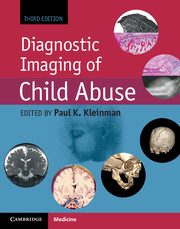Book contents
- Frontmatter
- Dedication
- Contents
- List of Contributors
- Editor’s note on the Foreword to the third edition
- Foreword to the third edition
- Foreword to the second edition
- Foreword to the first edition
- Preface
- Acknowledgments
- List of acronyms
- Introduction
- Section I Skeletal trauma
- Section II Abusive head and spinal trauma
- Section III Visceral trauma and miscellaneous abuse and neglect
- Section IV Diagnostic imaging of abuse in societal context
- Chapter 24 Psychosocial considerations
- Chapter 25 Child abuse and the law I: general issues for the radiologist
- Chapter 26 Child abuse and the law II: the radiologist in court and fundamental legal issues
- Chapter 27 The radiologist's response to child abuse
- Section V Technical considerations and dosimetry
- Index
- References
Chapter 25 - Child abuse and the law I: general issues for the radiologist
from Section IV - Diagnostic imaging of abuse in societal context
Published online by Cambridge University Press: 05 September 2015
- Frontmatter
- Dedication
- Contents
- List of Contributors
- Editor’s note on the Foreword to the third edition
- Foreword to the third edition
- Foreword to the second edition
- Foreword to the first edition
- Preface
- Acknowledgments
- List of acronyms
- Introduction
- Section I Skeletal trauma
- Section II Abusive head and spinal trauma
- Section III Visceral trauma and miscellaneous abuse and neglect
- Section IV Diagnostic imaging of abuse in societal context
- Chapter 24 Psychosocial considerations
- Chapter 25 Child abuse and the law I: general issues for the radiologist
- Chapter 26 Child abuse and the law II: the radiologist in court and fundamental legal issues
- Chapter 27 The radiologist's response to child abuse
- Section V Technical considerations and dosimetry
- Index
- References
Summary
Introduction
Child abuse is one of those unique realms where medicine and law are strange, but routine, bed fellows. Thus, it is incumbent upon physicians involved in the detection of child abuse and neglect to have some familiarity with the law. Physicians involved in child abuse cases often encounter a variety of issues that entail legal questions – patient consent, appropriate documentation, reporting child abuse, potential liability, privilege, and confidentiality. Despite questions about the law and the need for legal understanding, doctors often greet lawyers with a sense of anxiety, if not resentment. And, with concurrent dismay, attorneys sometimes resent what they perceive as a medical lack of cooperation with the legal process. However, the test of time has borne out that the sensitive management of family violence cases requires both professional spouses to not only communicate, but to get along (1).
It is not uncommon, if not the norm now, for hospitals and communities to have multidisciplinary child abuse-assessment teams who specialize in the assessment of suspected victims of abuse (2). Common participants of multidisciplinary child abuse-assessment teams include pediatricians, radiologists, ophthalmologists, surgeons, social workers, and mental health providers. Additionally, hospitals are not the only institutions that become involved. The thorough multidisciplinary management of child abuse cases includes police departments, district attorneys' offices, courts, and protective service agencies. Although child abuse laws are sometimes vague and poorly defined, there are three basic issues for the medical professional to consider:
When should the state intervene (e.g., is there a need to file a child abuse/neglect report) (3)?
How should the state intervene (e.g., what protective measures should protective agencies implement to ensure the safety of the child, and, what criminal charges, if any, should the state pursue against the alleged perpetrators)?
What legal requirements impact the physician's professional responsibility to the patient and the state (e.g., how should one document abuse in the medical record, and how do laws, such as HIPAA, impact medical record sharing with third parties, such as protective service agencies and attorneys)?
- Type
- Chapter
- Information
- Diagnostic Imaging of Child Abuse , pp. 638 - 644Publisher: Cambridge University PressPrint publication year: 2015



